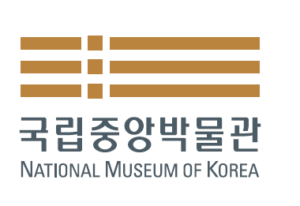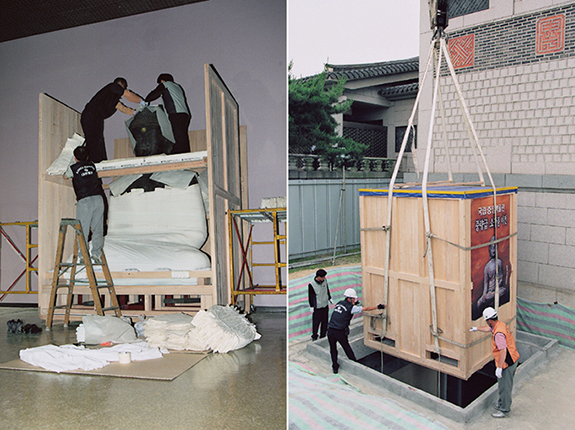Essay by Yang Heechung
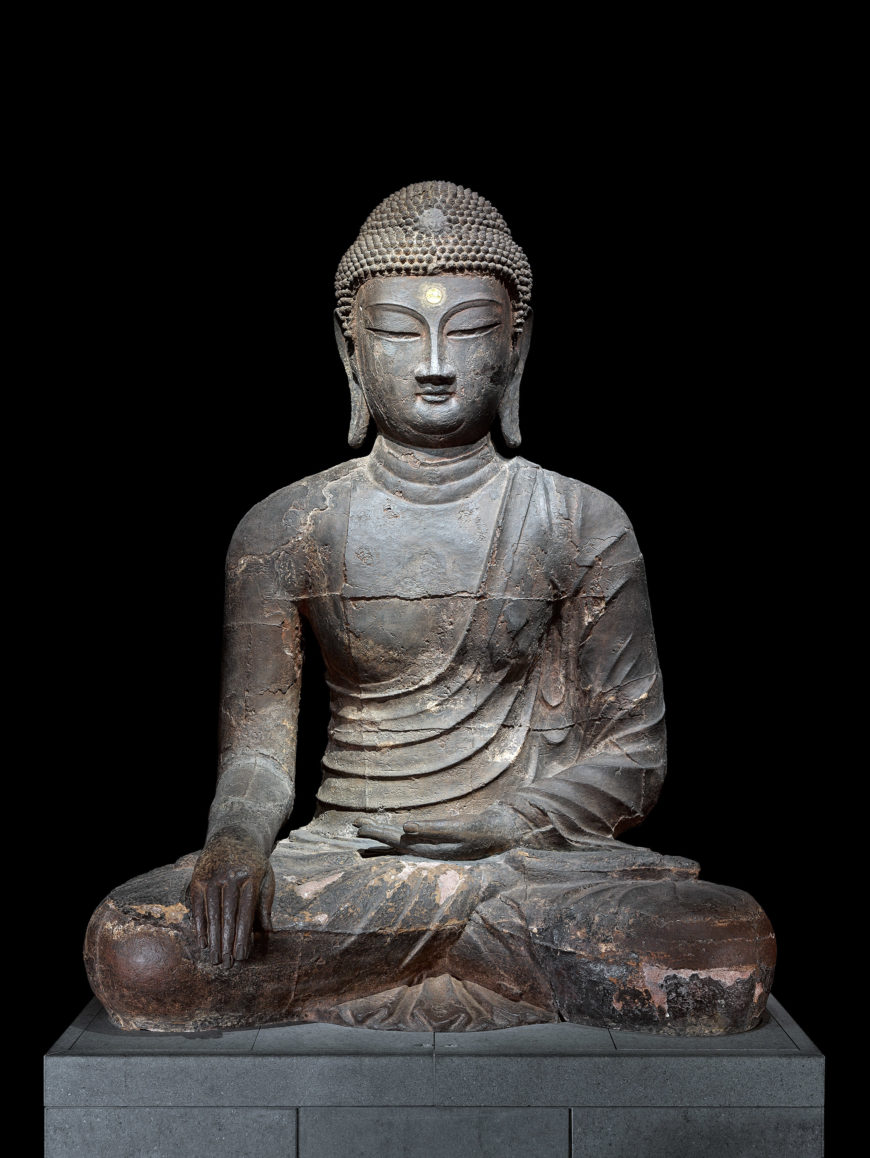
Cast-iron Buddha, Goryeo Dynasty (10th century), discovered in Hasachang-ri, Gwangju, Gyeonggi Province, height: 281.0cm, Treasure 332 (The National Museum of Korea)
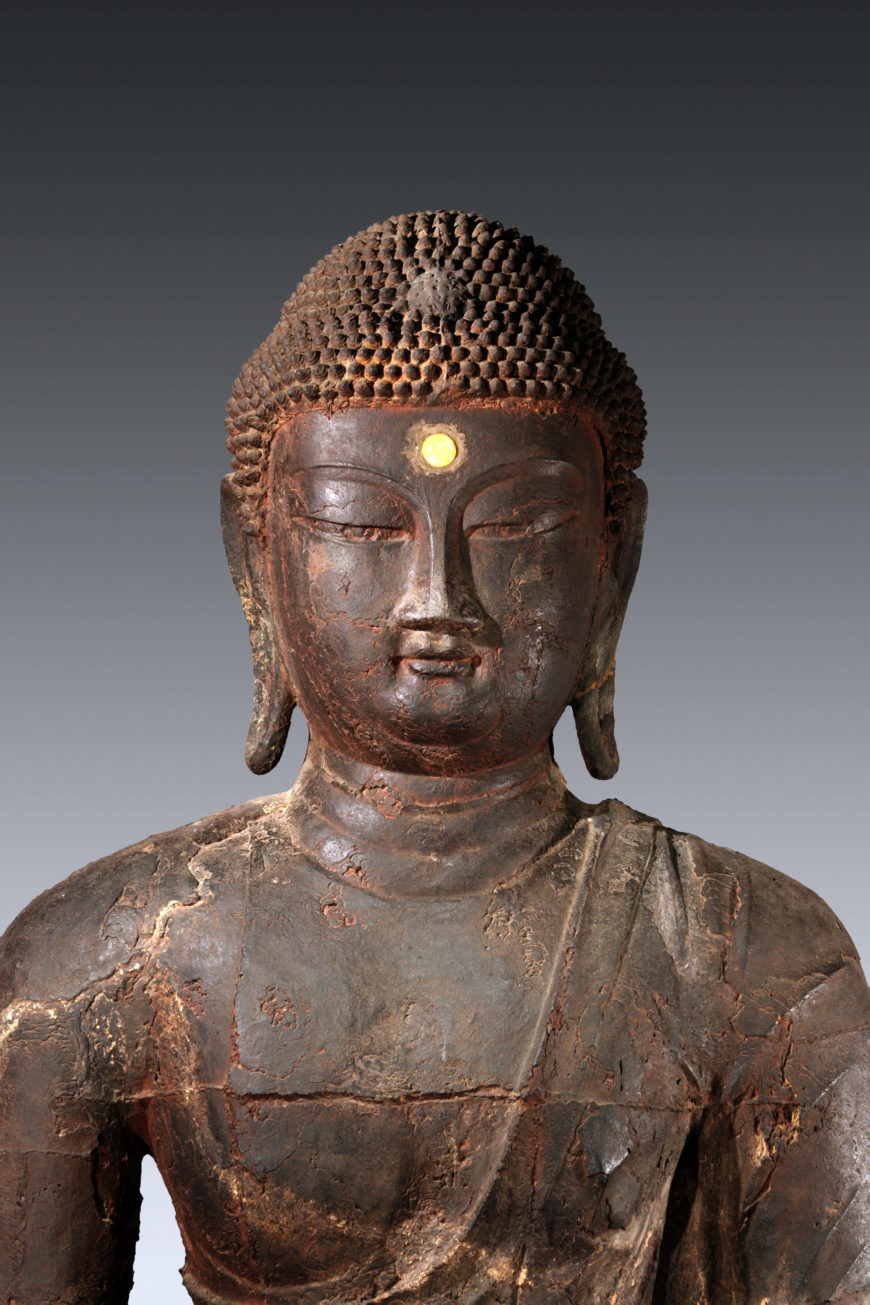
Detail of cast-iron Buddha, Goryeo Dynasty (10th century), discovered in Hasachang-ri, Gwangju, Gyeonggi Province, height: 281.0cm, Treasure 332 (The National Museum of Korea)
Majestic and Imposing
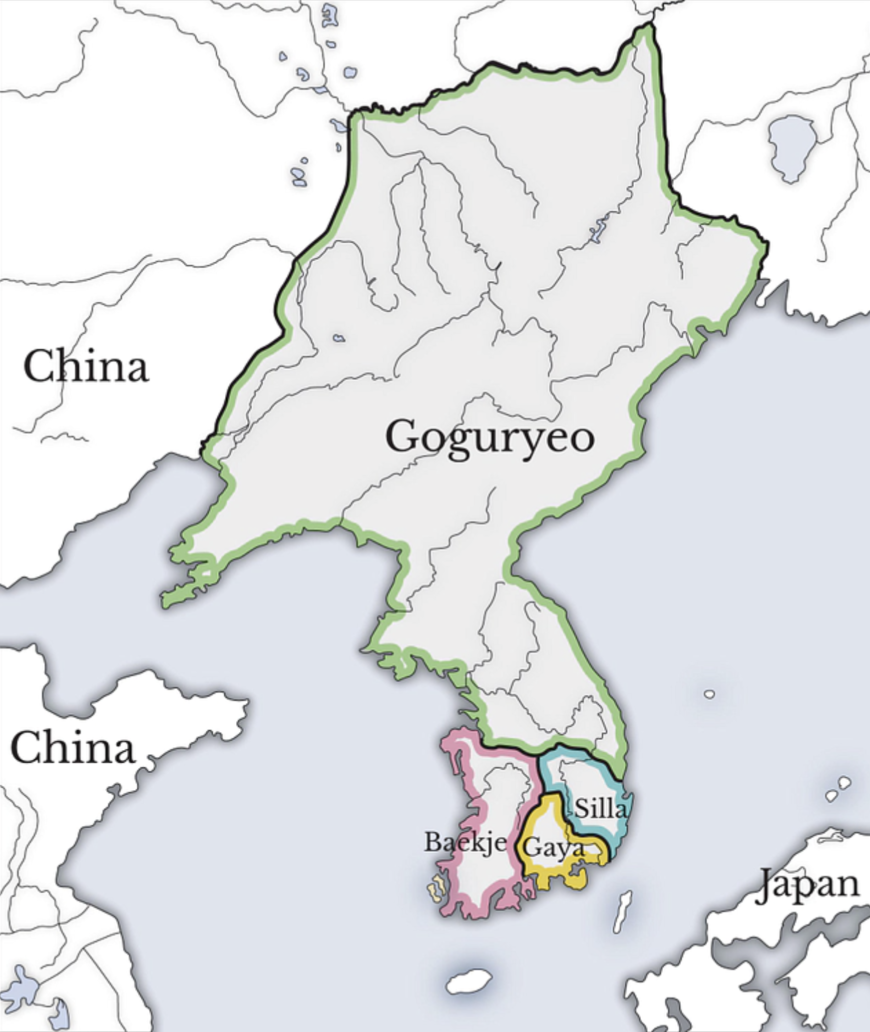
A map of the three kingdoms (Goguryeo, Silla, and Baekje,and includes the Gaya confederation), which ruled Korea between the 1st and 7th century CE.
The Buddha itself is almost 3 meters in height, and it sits upon a one-meter-high pedestal, so that the total height is close to four meters. Moreover, with its dark iron mass, stern face, brawny shoulders, and wide legs (stretching more than two meters from knee to knee), the Buddha presents a truly imposing figure. Unlike the round, smooth appearance of Buddhas from the Unified Silla period, which were typically made from light grey stone, this iron Buddha has a blank facial expression with no hint of a merciful smile. Among the many Buddha sculptures housed at the National Museum of Korea, it is rare to find one that exudes such a domineering presence, evincing the powerful aura of an actual deity.
Of course, the Buddha must have conveyed a different sensation when viewed in its original place of enshrinement. It was probably placed on a granite lotus pedestal, which might have been taller than the present one. But the biggest difference would likely have been the color; it is estimated that the Buddha was originally a sparkling gold, rather than its current dark brown. Traces of lacquer found on the knees indicate that the statue was likely once covered with a layer of gold leaf. No matter what material they are made from, sculptures of Buddha are often painted gold, gilded, or colored, reflecting the belief that the Buddha had a radiant gold body.
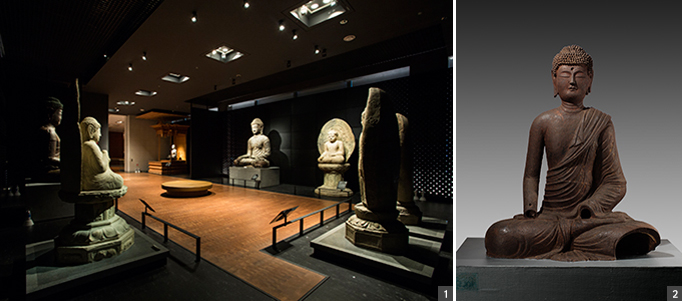
Left: Buddhist Sculpture Gallery of the National Museum of Korea; right: Cast-iron Buddha, early Goryeo Dynasty, discovered in Idong-myeon, Pocheon, Gyeonggi Province, Height: 132.0cm
Another iron Buddha from the collection of the National Museum of Korea, which was excavated from Idong-myeon, Pocheon, Gyeonggi Province, also bears traces of gilding, confirming that this practice dates back to the early Goryeo period. In any case, whether in its current setting or in its original gold splendor in the temple, this iron Buddha (Treasure 332) dominates the surrounding space with its palpable sense of majesty and nobility.
Relation to Powerful Local Clans of Early Goryeo
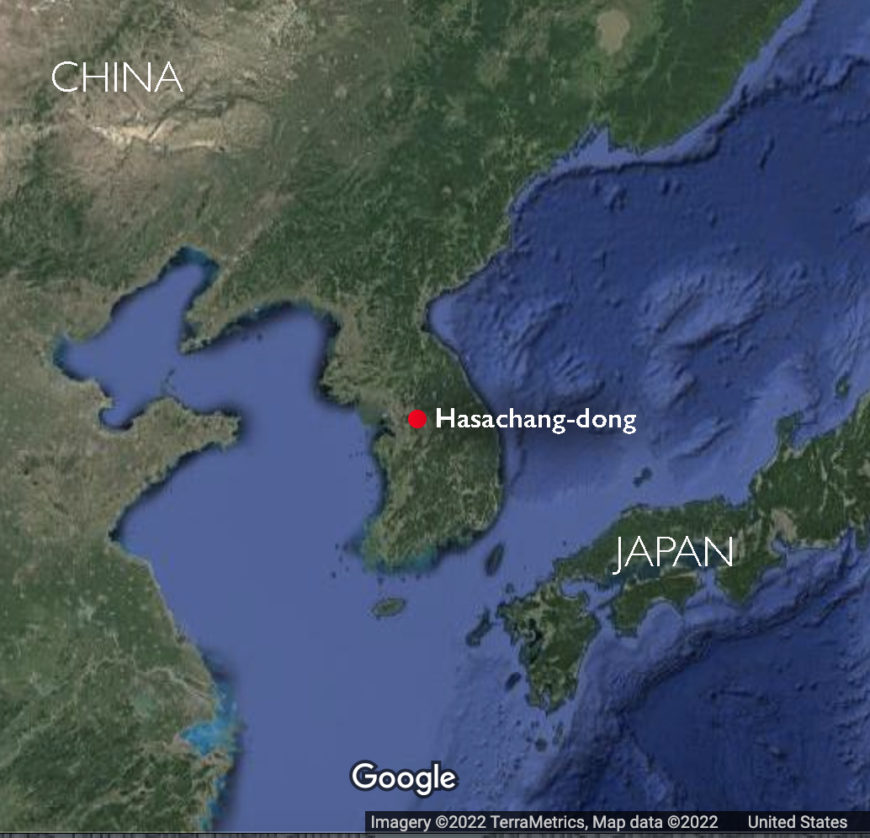
Map showing the temple site in Hasachang-dong, Hanam, Gyeonggi Province Korea (underlying map © Google)
This sculpture was discovered at a temple site in Hasachang-dong, Hanam, Gyeonggi Province, an area that was then part of Gwangju, according to the Goryeo administrative districts. As documented in Report on 1917 Survey of Korean Ancient Relics and Monuments (大正六年度古蹟調査報告), published in 1920 by the Japanese Government-General of Korea, two iron Buddhas (facing southward) were found at the site. The report states that the larger of the two Buddhas was transferred to the Yi Royal Family Museum, but makes no mention of what happened to the other sculpture.
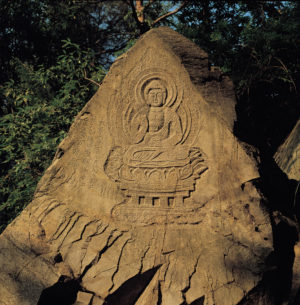
Rock-carved Seated Bhaisajyaguru Buddha, c. 977, in Gyosan-dong, Hanam, Korea
A later survey then revealed that there had once been a large Buddhist temple called Cheonwangsa Temple in the vicinity of this temple site. In addition, many Buddhist artifacts and relics were found within one kilometer of the site, including an octagonal pedestal (5.1meters in diameter), the site of Dongsa Temple, and the rock-carved Bhaisajyaguru Buddha in Gyosan-dong. Based on their impressive size and quality, the temple, the iron Buddha, and the other artifacts were likely created through the support of a powerful local community.
During the early Goryeo period, one of the most influential people in this area was Wang Gyu (王規, d. 945), the father of King Taejo’s fifteenth and sixteenth wives and the maternal grandfather of Prince of Gwangju (廣州院君). As the father of the two of the king’s wives, Wang Gyu expanded his power base until he controlled the area that was then Gwangju. During the reign of King Hyejong (惠宗, r. 943–945), however, Wang Gyu fell from power after losing a struggle over the succession to the throne. Thus, it is estimated that this iron Buddha was produced in the early tenth century, while Wang Gyu was still in power.
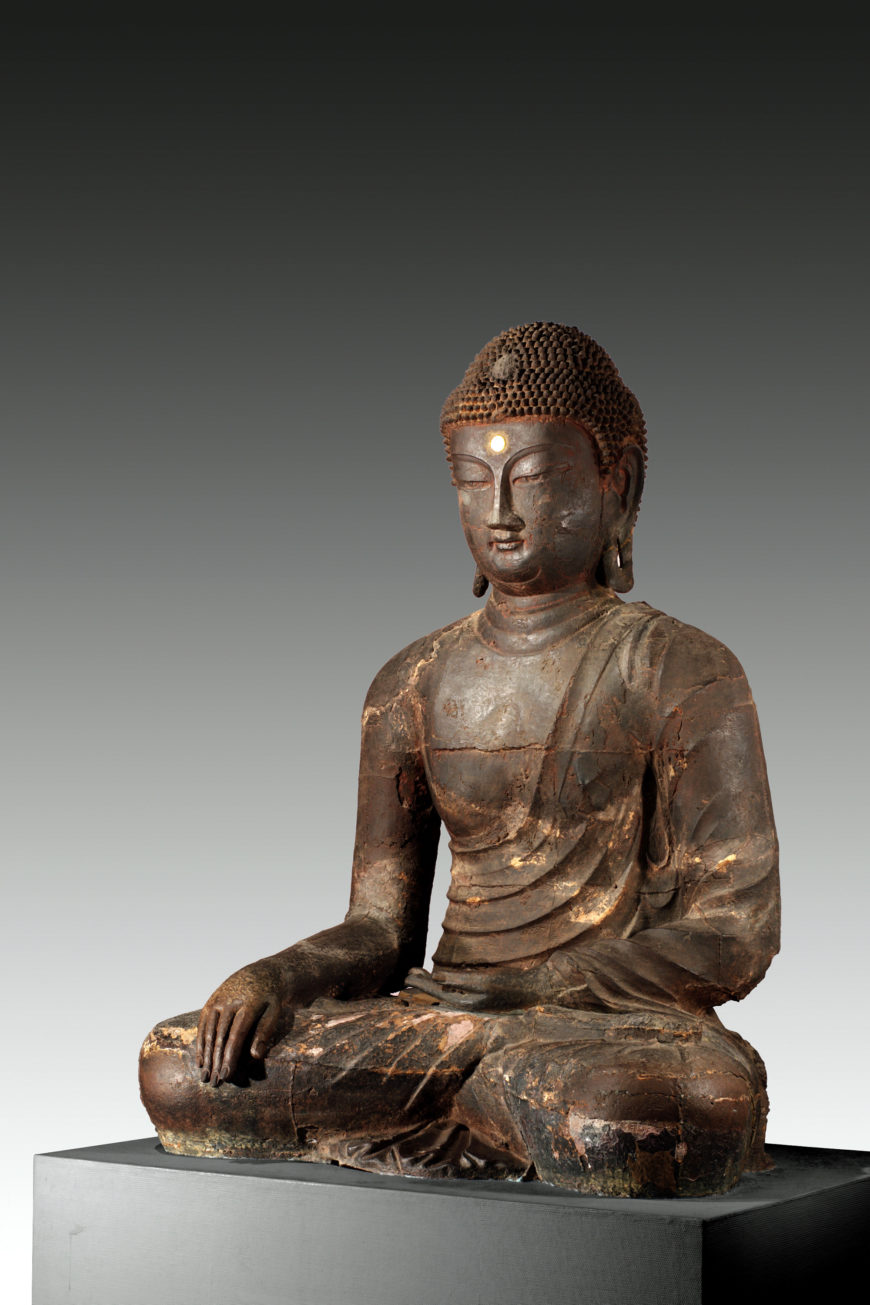
Cast-iron Buddha, Goryeo Dynasty (10th century), discovered in Hasachang-ri, Gwangju, Gyeonggi Province, height: 281.0cm, Treasure 332 (The National Museum of Korea)
Iron: The Best Choice at the Time

Map showing iron Buddhist statues concentrated in the central area of the Korean peninsula (underlying map © Google)
In Korean history, iron was actively used to create Buddhist sculptures for only a short period of time, from the late Unified Silla to the early Goryeo period. As such, there are only about fifty extant examples of iron Buddhist sculptures. While Buddhist statues made from gilt-bronze, granite, and wood have been found throughout the country, iron Buddhist statues are concentrated in the central area of the Korean peninsula (e.g., Gwangju, Gyeonggi Province; Gaeseong; Cheolwon and Wonju, Gangwon Province; Seosan and Cheongyang, South Chungcheong Province; Chungju, North Chungcheong Province; and Namwon, North Jeolla Province). The fact that iron sculptures have not been found around Gyeongju, the former capital of the Silla Kingdom, indicates that they were primarily produced in remote areas of Silla.
Iron is not generally considered an ideal material for producing Buddhist sculptures for various reasons, including its rough surface, its melting point (which is higher than that of bronze), and its tendency to rapidly harden as the temperature decreases. These characteristics make it very difficult to create elaborate sculptural details, such as facial expressions, hands, and the creases in the robe.
But from the late Unified Silla to the early Goryeo period, sculptors often had little choice but to use iron. At the time, the social atmosphere for Buddhist dedications and offerings was not very favorable. In 806, Silla’s King Aejang (哀莊王, r. 800–809) banned the construction of Buddhist temples, for fear that Buddhist temples and communities, with their financial power and monk soldiers, might unite with aristocrats against the throne. Then in 834, seeking to redress the excess extravagance of the contemporaneous culture, Silla’s King Heungdeok (興德王, r. 826–836) ordered that the use of certain materials would be limited to those of high social status. Within this environment, ordinary people who wished to make Buddhist dedications and offerings likely began using more common materials that would not draw the attention of authorities.
The situation was compounded in the 840s due to the death of the influential Silla merchant Jang Bogo (張保皐, d. 846), who had commanded maritime trade on the Yellow Sea and controlled the domestic supply of bronze. After Emperor Wuzong (武宗, r. 841–846) of the Tang Dynasty decreed that Buddhism was to be eliminated, damaging Silla’s trade with China, the overall supply of bronze in Silla steadily decreased. When King Taejo founded the Goryeo Dynasty around 918, he ordered the establishment of numerous Buddhist temples, but the supply of bronze was still too low to meet the demand. Thus, in spite of its drawbacks, iron came to be considered as the best available alternative to bronze for creating Buddhist sculptures.
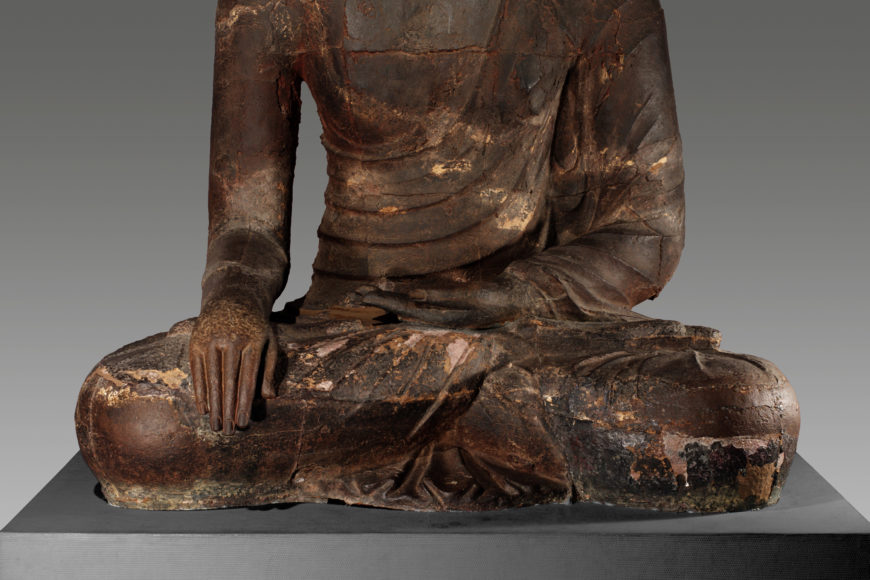
Cast-iron Buddha, Goryeo Dynasty (10th century), Discovered in Hasachang-ri, Gwangju, Gyeonggi Province, Height: 281.0cm, Treasure 332
Even so, the actual practice of producing sculptures from iron presented many challenges. In principle, the casting process for iron is the same as that for a gilt-bronze sculpture. Unlike bronze, however, which can be easily chiseled after casting, iron is much more difficult to smooth and trim, due to its hardness and higher melting point. Also, because of their large size, most iron Buddha statues were cast with multiple moulds. The molten iron inevitably seeps into the gaps where the moulds are joined, leaving obvious traces. For example, this iron Buddha shows such lines on the chest, waist, knees, and sleeves.
Why Such a Large Iron Buddha?
This iron Buddha is monumental in size, and it is not the only one of its kind. Historical records and evidence indicate that many of the iron Buddha sculptures produced during this period were quite large. Why did Buddhist temples need such huge statues?
The purpose of such statues is illuminated by examining the history of Bongamsa Temple, which was established in Mungyeong, North Gyeongsang Province in the late ninth century. According to records, the temple site was surrounded by mountains that served as a refuge for bandits, including many former farmers who had been impoverished by famine and harsh taxation. Concerned that the area “would become a nest of bandits without a Buddhist temple,” the Great Master Jijeung (智證大師, 824–882) ordered the construction of a:
house with a tiled roof that protrudes at the four corners of the eaves, in order to suppress the energy of the surrounding topography, and the casting of two iron Buddha statues to protect the temple.
The example of Bongamsa Temple indicates that large Buddha sculptures were produced to guide and protect people during the period of social turmoil that accompanied the fall of the Unified Silla Kingdom. To effectively serve such function, the sculptures required a stern and authoritative look, enhanced by their massive size. The use of iron to produce the sculptures can be explained by the proximity of major iron mines (e.g., in Chungju) and the relative accessibility of iron, due to recently established maritime routes for transporting tax goods.
Moving a Giant
In 2005, the National Museum of Korea was relocated from Gyeongbokgung Palace to Yongsan. Of the approximately 100,000 works in the museum’s collection, few (if any) were more difficult to transport than this Buddha. Then kept in basement storage, the Buddha was too big to fit in an elevator and too heavy to carry up the stairs. Thus, a large hole was dug on one side of the basement and an entire wall (3 x 3 meters) was torn down. After being meticulously wrapped in paper and fabric and then crated, the statue was lifted out of the basement with a crane. It was then placed on a special anti-vibration truck and driven to Yongsan. Even with the most advanced twenty-first century equipment, simply moving the Buddha was an arduous process, which makes us consider how desperate and earnest people must have been to produce and enshrine this sculpture around 1000 years ago.
